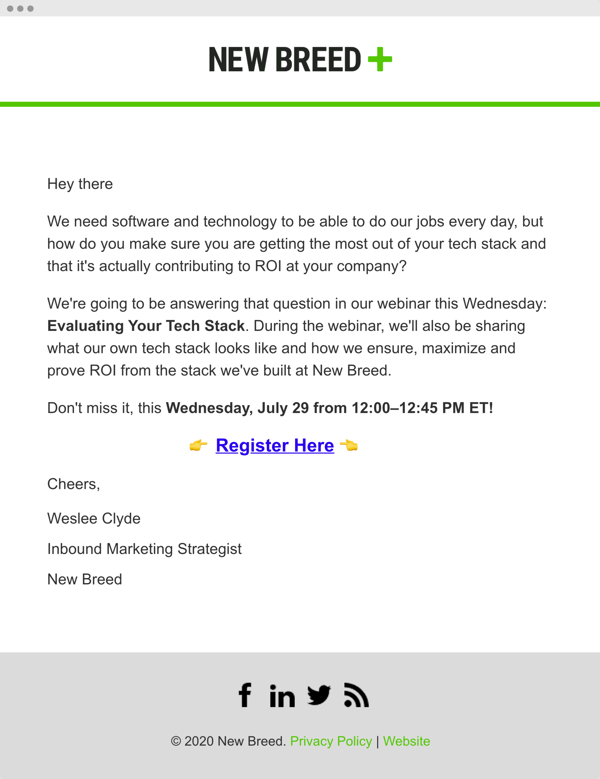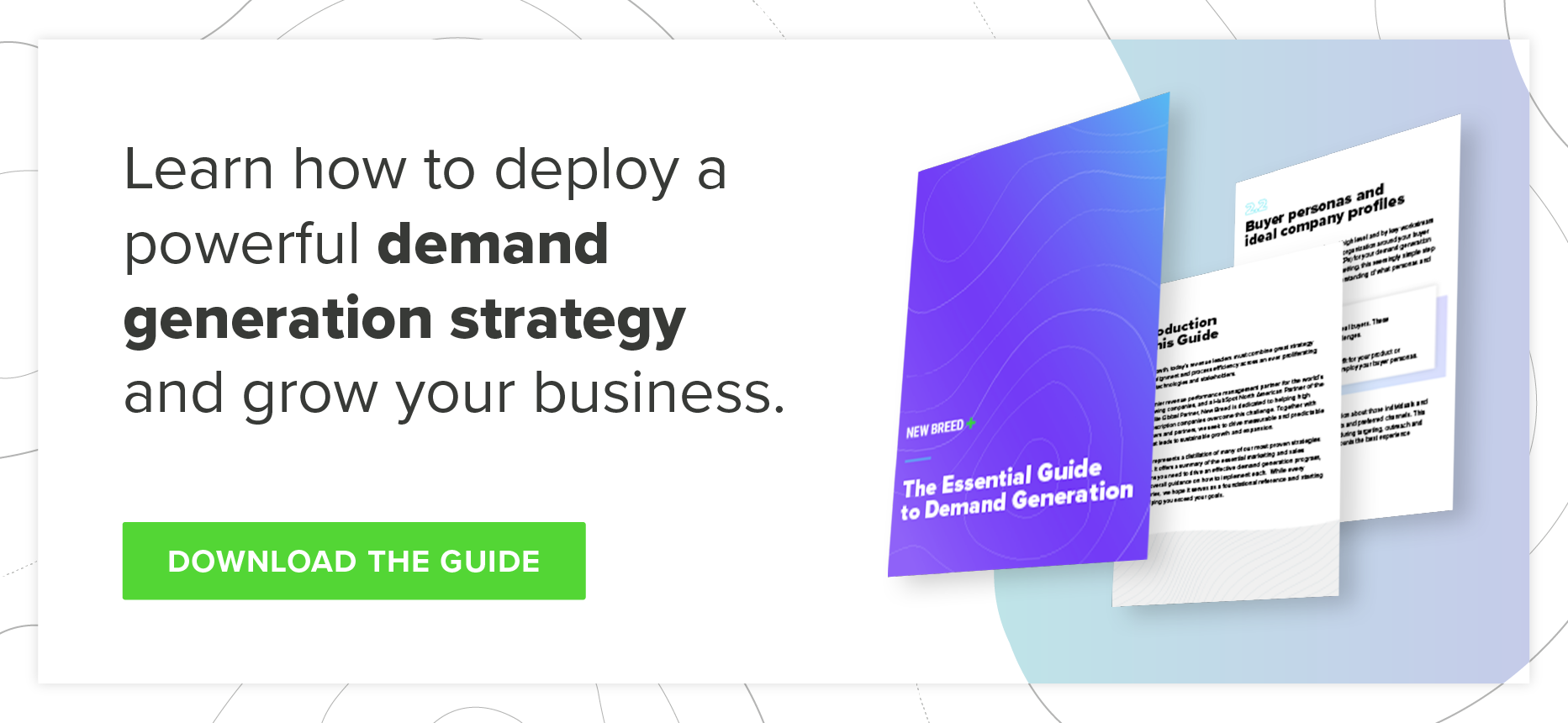7 Components of a Successful Marketing Email
Emails are an essential part of any marketing strategy. They are a great way to build relationships with prospects, promote content or events and stay connected with customers all while showcasing your brand.
While there is no formula for creating the perfect email, there are some things you should always be doing to ensure your emails have the highest chance at success.
Here are seven components of a successful marketing email:
1. A Clear Call-to-Action
The purpose of sending out an email is to engage with users in some way or another. The type of engagement you’re looking for will depend on the type of email you are sending out.
Your goal for the email may be to get users to click a link, sign up for an event, complete a form on a landing page or even just reply. But, regardless of the type of email you send, defining that goal before drafting your email will help you make sure you are presenting a key action you want users to take in each email. This will allow you to stick to a clear call-to-action and remove any friction from users’ experience.
You want to be sure that each email you send only has one main call-to-action. In terms of design or layout, this is usually a link, a button, in-text instructions or a video. That isn’t to say that you can’t ever have more than one link in an email, but you want to have one very clear next best step outlined.

We use a centered text that is typically bold and a bit larger or underlined to indicate the link or button we want users to click after reading the body text in the email. This eliminates confusion when reading the email and encourages users to click the one thing that is most important.
2. Segmentation and Suppression Lists
One of the best things you can do for your email strategy is to have strong segmentation and suppression. Both of these elements will help increase your open and engagement rates as well as ensure you are sending your audience emails that are a good fit for them and providing real value.
Segmentation
The more you are able to segment the people who receive your emails, the better results you will see. Segmentation is using your database or CRM to group similar individuals and serve them emails that are of specific value to them.
For example, you could make a list of people who use or are interested in a certain product of yours and send them product updates and information related to what you know they are interested in. This will help your audience get more value from your emails as well as give you the ability to get more specific and personal knowing the people receiving your messages are actually interested in their contents.
Suppression
Segmentation is how you choose people who will receive your emails, and suppression is how you stop people from receiving them. You can use your marketing automation platform to create a list of people who you don’t want to receive a specific email and add them as a negative list when sending out an email.
There are many different ways you can use suppression. You may want to create a master “do not send list” of people who are unengaged with your brand. Additionally, if you are using emails to promote content of any kind, you should create a list of people who have already seen the asset you are promoting in that specific email and suppress them to be sure nobody gets an email promotion for something they have already viewed or signed up for.
3. An Intriguing Subject Line
Subject lines can be tricky. There is a lot of pressure to get the subject line right by being flashy, catchy or intriguing in order to get viewers to open your email.
But, I strongly believe that while subject lines may help, your brand and the value you provide are what truly entice people to open your emails.
If you are a brand or a company that your audience can trust as a valuable source of information, the subject line won’t matter as much because they will always open your emails anyway because you are someone they count on for value.
But, there are still instances with new contacts or subscribers that you want to get their attention, and a subject is still a great place to kick-off excitement about the email’s content.
Here are a few general dos and don'ts for writing a subject line:
Do:
- Be specific
- Hint at the value of the email
- Use an exciting or fun line
- Include personalization tokens if possible, like name or company
Don’t:
- Use all caps — there’s no need to shout at your readers
- Include filler words like “hey” or “thanks”
- Ask a yes or no question
- Trigger spam filters with the use of too much punctuation or the word “free”
- Overuse punctuation of any kind
4. Great Copywriting
There is no perfect length for the best emails. The length of your email depends on the type of information you are sending, what your audience prefers and what fits your brand.
Your emails should strike a balance between being as precise as possible while also providing the necessary context. I prefer to stick to short emails that get right to the point. There are certainly situations that warrant a longer email and explanation, but keep in mind that you are competing for your audience's time in an inbox probably full of other emails.
The more concise and to the point you can be, the better chance you have of keeping your reader’s attention through the entire email.
But, regardless of if your email is four paragraphs or four sentences, you should always be checking for grammatical errors. If readers are distracted by typos or sentence structure, it may prevent them from reading the whole email or taking the desired action.
5. Personalization
When using an email automation platform it’s easy to get into a routine, but utilizing things like personalization tokens is a great way to offer an individualized experience for your audience even though you are using an automation tool.
“First name” is a great and easy personalization token that should be in every email. You can also use things like company name or even use custom properties when it makes sense to do so to build sentences that speak to a user's own situation or needs.
For example, I may use the property “marketing automation platform” when I am sending out an email that is focused around tips for segmenting your database. Because we have that property filled in on our own contact records, I can enter it into the first sentence to create a custom email around the actual marketing automation platform each recipient uses. This helps create a better user experience that’s more personalized.
6. Testing and Previewing
While testing and previewing isn’t a physical component of your email, it'll ensure everyone receives the message as you intended. You may have created the best email ever, but if nobody can see or read it, it won’t matter how great it is.
Different devices and email clients have different display settings and capabilities, so how an email is displayed will vary depending on if the reader is using a Mac computer or an android phone and accessing it through Outlook, Gmail or Apple Mail.
Your formatting and the content you include in your emails need to take into consideration how it will be viewed by the end-recipient.
For example, while emojis are great to convey emotion and add pizzazz to an email, not all emojis show up correctly on different devices.
Most email automation platforms will allow you to preview emails in different browsers as well as see what the email will look like on a mobile device, so be sure to check those out before hitting send.
7. Unsubscribe and Email Preferences
We never want users to unsubscribe from our emails, but that doesn’t mean that you should hide the way to do so. In fact, putting your preferences and unsubscribe buttons in a clear and easy to find location will actually convey a sense of trust to your readers.
Let’s be clear — your un-subscribe button should not be as large or noticeable as your body text or call-to-action, but it still needs to be easily found in case that is the path a user wants to take.
The Takeaway
There is truly no one-size-fits-all way to go about building your email marketing strategy. You know your customers and prospects better than anyone else, so listen to them and their needs.
Test out different formats, designs, wording and even the types of emails you send out to see what your audience engages with most.
Lastly, get creative and don’t be afraid to change things up. Over time, you will find what works best for you. As long as you’re communicating honestly and providing real value, readers will appreciate your emails and keep coming back for more.
Weslee Clyde
Weslee Clyde is an inbound marketing strategist at New Breed. She is focused on generating results using inbound methods and is driven by the customer experience. When not at the office, you can find her binging a docu-series on true crime or perfecting her gluten-free baking skills.





